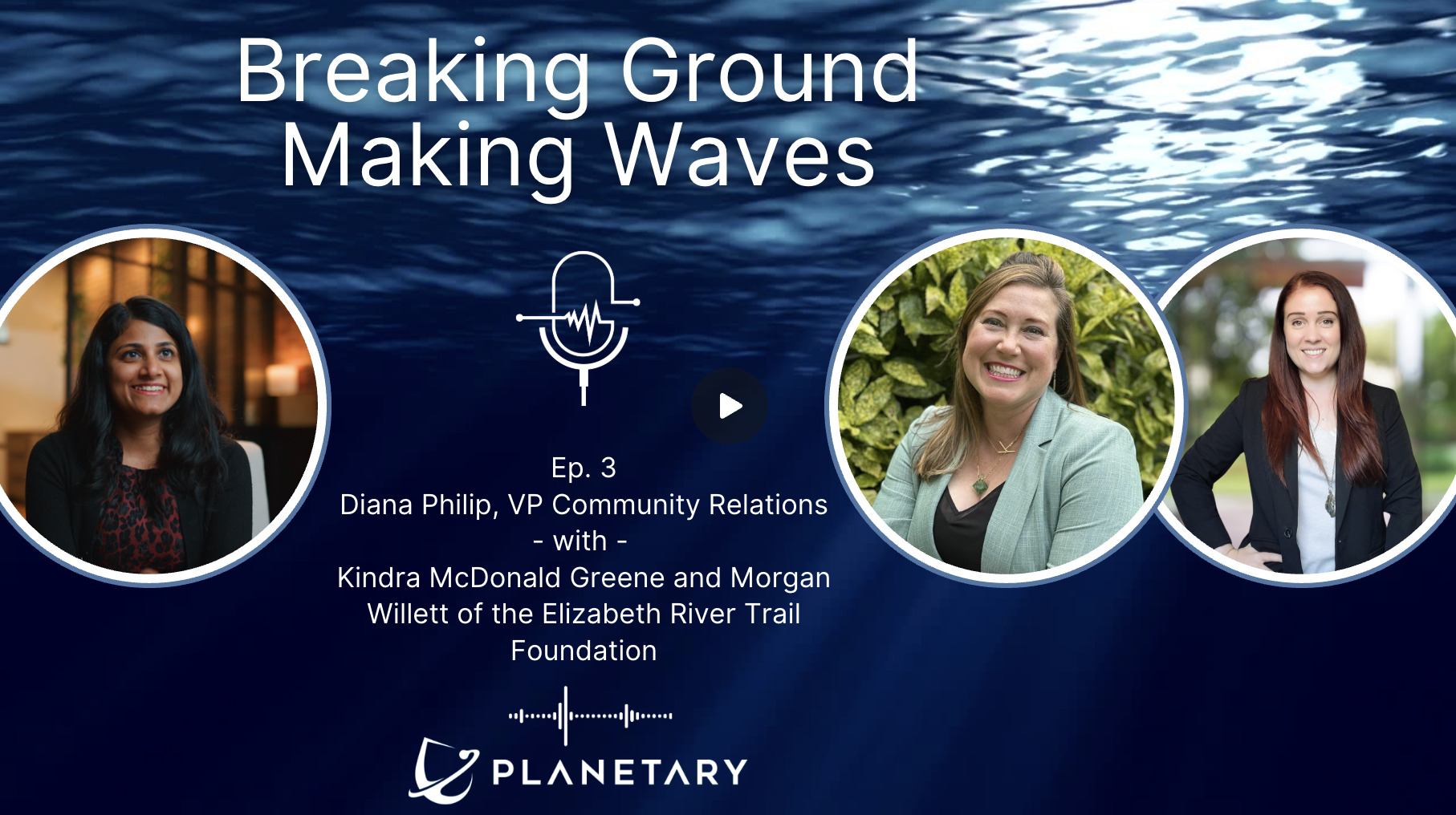
Building Bridges, Not Just Trails: How the Elizabeth River Trail Connects Norfolk’s Communities to Each Other—and to Nature
At Planetary, we believe in the power of community-led climate action. That’s why our project at the Elizabeth River in Norfolk, Virginia, is about more than carbon removal, it’s about connection. And no one embodies that spirit more than Kindra McDonald Greene and Morgan Willett of the Elizabeth River Trail Foundation.
We sat down with Kindra and Morgan for Breaking Ground, Making Waves, our spotlight series that lifts up local leaders reshaping their communities through innovation, resilience, and environmental stewardship. What followed was a warm and inspiring conversation about the power of green space, the importance of accessibility, and what it really takes to steward a city-scale trail with a small team.
What Is the Elizabeth River Trail?
Many people picture forest paths when they hear “trail.” But as Kindra Greene, the Foundation’s Executive Director, shared, “We are a very urban trail. Our trail runs through 28 neighborhoods, connecting communities for 10.5 miles, hugging the Elizabeth River as closely as possible.”
Unlike most urban trails that briefly touch city spaces, the Elizabeth River Trail (ERT) is fully urban, running through Norfolk’s neighborhoods, waterfronts, and industrial corridors. The trail is also a frontline witness to the effects of sea level rise. Second only to New Orleans on the East Coast, Norfolk is facing intensifying flooding, and the ERT is responding with infrastructure that acts as a sponge, a bridge, and a storyteller.
“We’re using native plants, bioretention infrastructure, and green pockets to absorb stormwater and create sanctuaries for people and pollinators alike,” Kindra explained. “This trail is more than recreation. It’s resilience in action.”
More Than a Path: A Platform
Assistant Director Morgan Willett organizes over 100 events a year on the trail. From massive community cleanups to quirky favorites like the Halloween Puppy Parade and Glow Party, the programming is designed to engage everyone—not just runners and cyclists.
“We want people to know they don’t have to be super outdoorsy to enjoy the trail,” Morgan said. “You can learn about native trees, take a historical kayak tour, or just enjoy some local cheese tortellini at a winter market.”
Perhaps one of the most remarkable features is the Glow Line. The Glow Line is the first glow-in-the-dark trail segment on the East Coast, created with embedded phosphorescent stones in the shape of Virginia-native fiddlehead ferns. It’s both beautiful and practical, lighting the way through a tree-covered area that can’t accommodate traditional lighting due to city park rules and wildlife sensitivity.
A Vision Rooted in Equity and Access
The ERT Foundation is a young nonprofit, just eight years old, but it’s already catalyzing transformational change. With only three staff members and an army of committed volunteers, the team is making sure the trail is accessible, inclusive, and community-driven.
“A lot of people think the trail is paid for entirely through city taxes,” Kindra noted. “But we’re raising private funds for a public good. That requires constant storytelling and trust-building.”
The Foundation’s guiding philosophy? Move at the speed of trust. Whether that means planting pollinator gardens with youth groups, installing shaded benches in under-resourced neighborhoods, or simply listening to what a community wants—their mission is shaped by the people it serves.
The People Behind the Trail
Kindra’s background spans creative writing, national security, and nonprofit leadership. “I took a winding path,” she said, “but every piece of it informs how I lead. I never thought I’d be the person in a hard hat overseeing trail construction, but here I am.”
Morgan’s journey went from cosmetology to environmental science to a bachelor’s in leadership. “I discovered my passion for the environment by accident—literally while learning about dirt,” she laughed. Now, she leads stewardship programming and volunteer engagement, ensuring that the trail’s green infrastructure doesn’t just get planted—it thrives.
A Shared Future
As Planetary deepens its roots in Norfolk, the partnership with the Elizabeth River Trail Foundation offers a living example of how climate innovation and community can go hand-in-hand. Together, we’re working not just to remove carbon, but to restore and reimagine the landscapes that make our cities livable, equitable, and resilient.
And yes, we will definitely be showing up in October for the Puppy Parade.
Want to learn more or get involved with the Elizabeth River Trail?
Visit elizabethrivertrail.org or follow them on social media for upcoming events and volunteer opportunities.
Stay tuned for more episodes of Breaking Ground, Making Waves, where we highlight the local leaders making global change.
